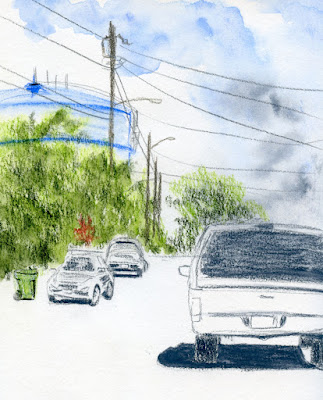 |
| 5/18/20 sketch journal page |
“Sketch journaling” has varying interpretations by its many
practitioners, but in general, it’s a journal format that incorporates both words
and pictures that describe one’s day. Admiring the sketch journal processes I’ve
seen online, I’ve tried making such pages a few times, but it hasn’t been a
format that “sticks” as a regular habit. As a journal writer my whole life,
maybe it’s just too easy for me to fall back on words, the format I’m used to.
In any case, when Urban Sketchers Japan’s weekly challenge
was to make a sketch journal, I was inspired to give it a shot again. One
aspect that interested me was that the group intended to stay focused on urban
sketching, which means drawing only from life, not photos or imagination, and “telling
a story” with their subject matter and its context. This was a familiar form of
sketching that I could reach for easily.
I found myself
somewhat hyper-aware of my mundane activities that day, seeking out whatever
was more visual to describe with sketches. Taking a walk was easy; I just
stopped at a traffic circle and sketched a parked car and trailer. Our Fred
Meyer grocery pickup was so mundane and non-visual (the pickup spot is a dark
garage) that I almost skipped it, but it was the only thing we “did” that day!
I felt compelled to include it.
By dinnertime, I had filled the page spread with five small
sketches describing my day. As you can see, not much happened. On the other
hand, that day is now more memorable than the other six (similarly mundane) days
that week because I made this page. And more important, I enjoyed the process.
It was both challenging and fun to think about my activities in a visual way.

















































